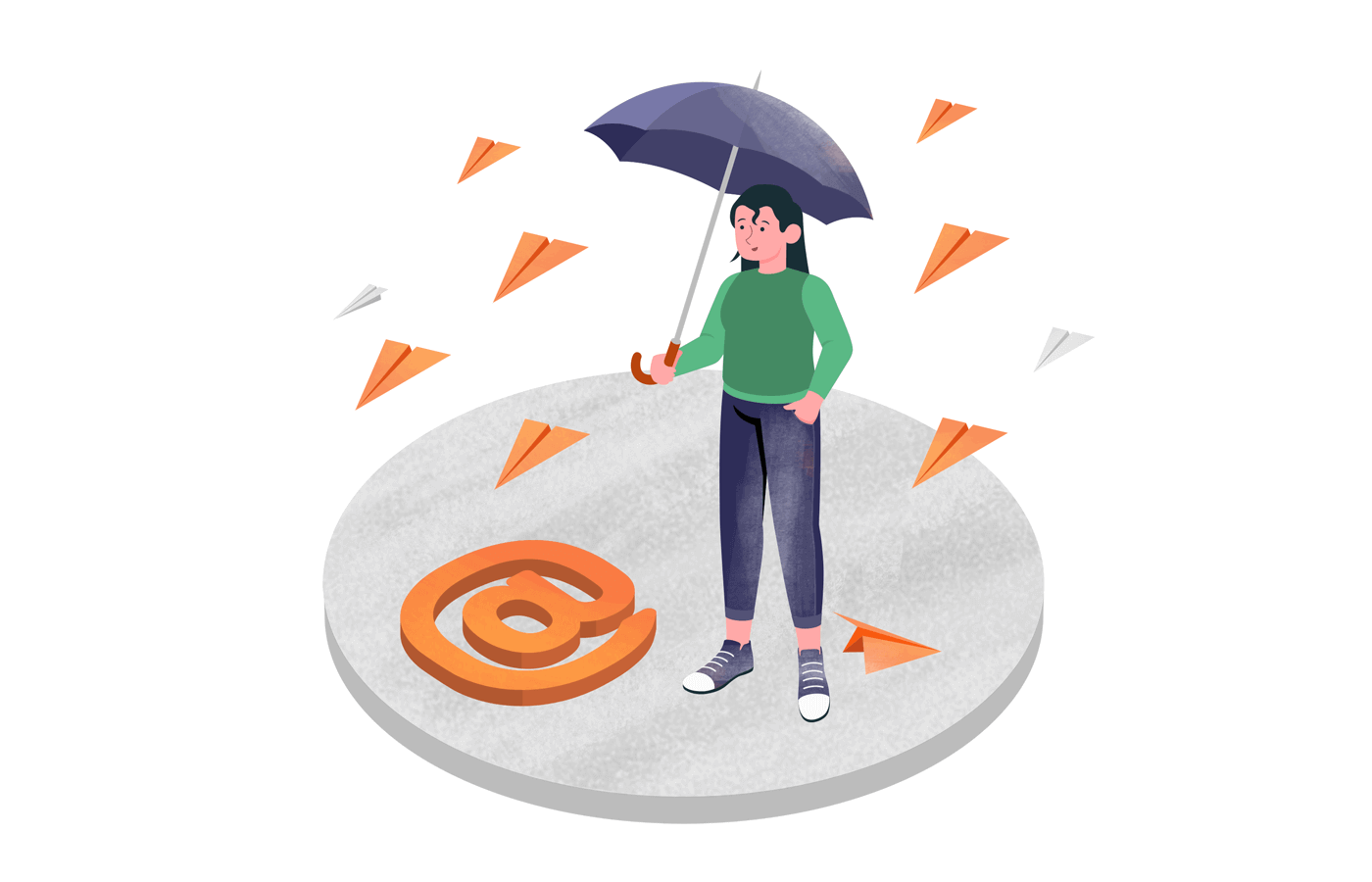Email drip campaigns are a great way to engage with your audience. They help marketers to automate email workflows and achieve desired results on autopilot.
But what makes a good drip email campaign? Are all of them made the same way? Not necessarily. For your drips to be successful, you should know when, how, and to whom to send them.
Are you eager to improve your drip campaign strategy? Stay tuned as we share 16 drip campaign emails to help you optimize it.
What is a Drip Campaign?
A drip campaign is a sequence of automated emails triggered after the user completes a specific action.
For example, when a user signs up for your marketing communication or product, you can send them a welcome drip campaign. Thank them and introduce the basic features of the product/service with the first email. With the second email, concentrate on distinguishing aspects of the product. And in the third email – wrap things up and motivate the user to act.
Automated drip campaigns are triggered based on a specific activity and automatically execute the whole campaign within a pre-set time frame. An effective drip campaign leverages the advantages of an automated email marketing strategy without too much effort or resource utilization.
16 Email Drip Campaign Examples for Every Situation
Now that we have the theory out of the way, let’s explore the best drip email campaigns for different goals. Use them as inspiration to create unique and effective drip marketing campaigns.
- Welcome Series Drip Campaign
- Onboarding Emails
- Re-Engagement Drip Campaign
- Customer Retention Drips
- Win-Back Campaigns
- Action Completion Drips
- Lead Nurturing Campaigns
- Post-Purchase Email Drip Campaign
- Cart Abandonment Campaign
- Upselling Drips
- Engagement Drip
- Recommendations Drip
- Renewals Drip
- Informational/Educational Drip
- Personalized Drip Campaign
Let’s look at each of these email drip campaign examples one by one.
Welcome Email Series
A welcome email series is a great way to welcome new subscribers, thank them for joining your list, and introduce the features of your product/service. Break down all this information in multiple welcome drip emails instead of one to launch your welcome email series.
Subject line: Welcome to Canva. Let the creative fun begin!
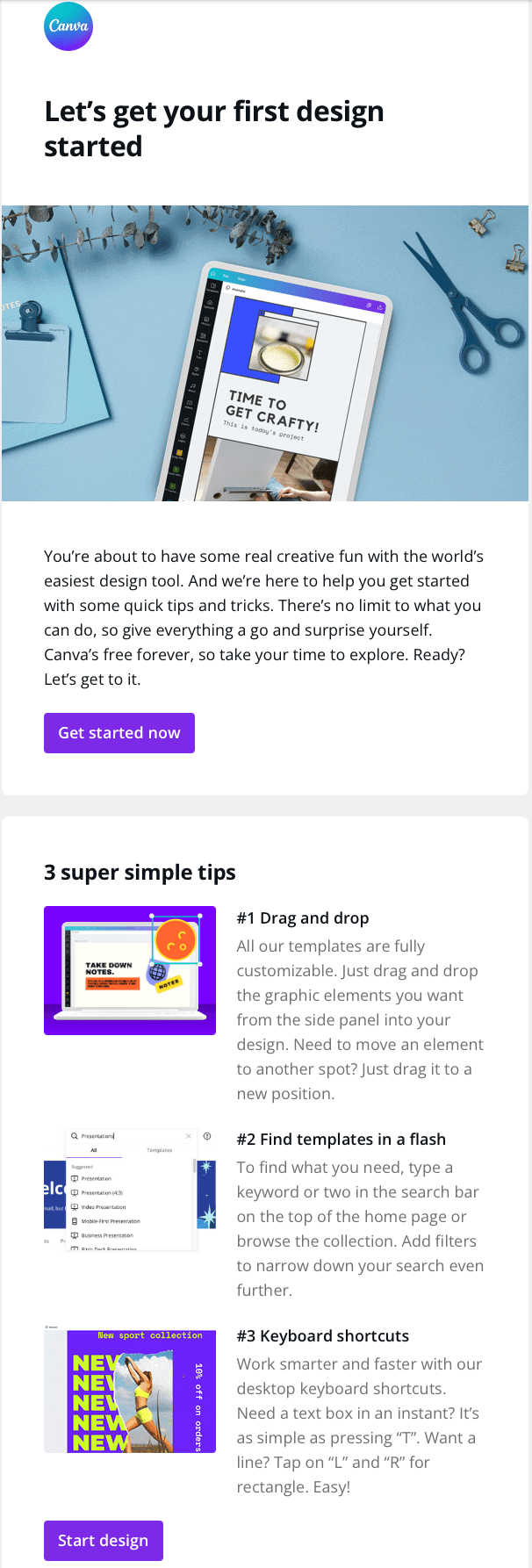
Here’s a successful drip campaign example from Canva. The first welcome email provides some tips to help the user get started. The second email introduces specific tools to underline the diversity of the platform, while the third email focuses on available templates.
The subject line is simple but creative. It sets the right expectations and aligns with Canva’s brand identity.
Key Takeaways:
- Keep the logical link between the sequences of your welcome drip campaign;
- Add visual snippets of the tools you’re promoting for more clarity;
- Use humor in your email copies to drive user engagement.
First impression is always important. Here’s 12 more welcome email examples to engage customers.
Onboarding Campaign
Onboarding drip email campaigns can effectively educate your subscribers about your product or services. Think of it as an educational course where each email equals a specific lecture. With easy-to-follow steps, you can help subscribers navigate through your platform without facing any issues or blockers
Subject line: You’re on your way to a shining resume!
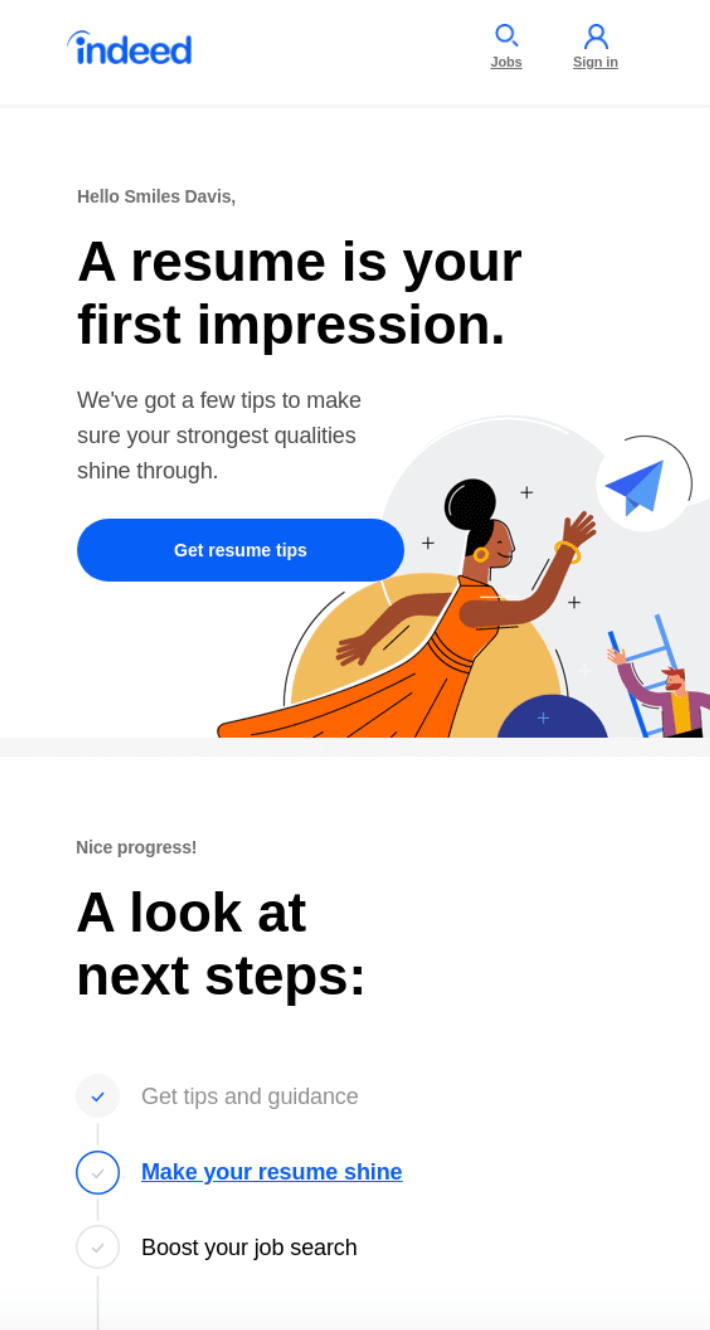
In the email sequence above, Indeed uses email personalization and addresses the user by their name. The first CTA button is short and clear and fits the context perfectly.
Next comes the checklist that creates the right expectations for the rest of the email (and drip campaign) and gives structure to the onboarding process.
Distinctive and consistent design is a cherry on top.
Key Takeaways:
- Concentrate on providing informational content and bringing value to the user;
- Create a clear structure not only for the first email but also for the whole drip;
- Personalize your campaign by addressing the user by their name or customizing the campaign according to their interests (if you have that data, of course).
Creating email campaigns with Sender is easy. Automating them — is even easier. Give it a shot and optimize your email marketing.
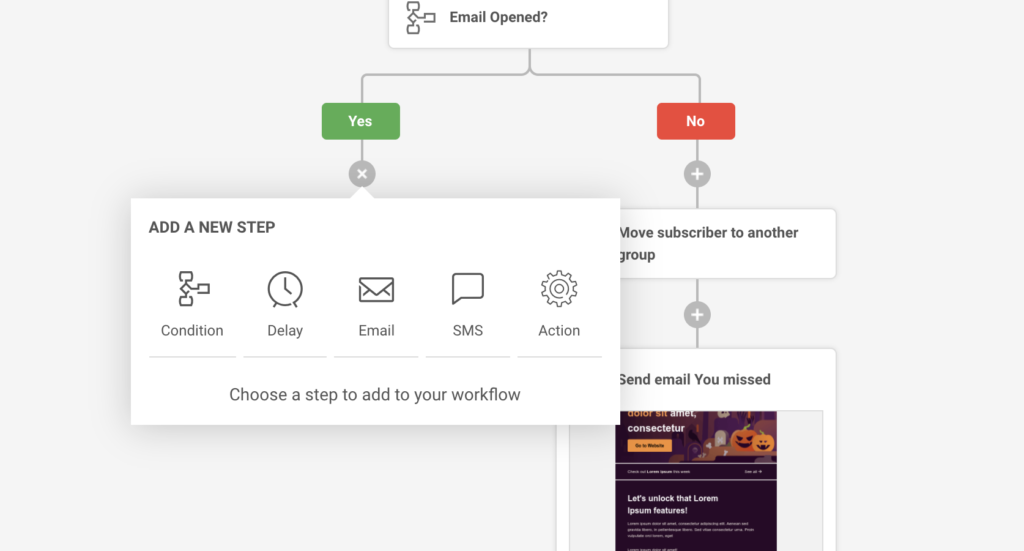
Re-Engagement Campaigns
No matter how engaging your marketing campaigns are, you can’t avoid inactive subscribers. At some point, some users will stop interacting with your emails. And that’s exactly when you’ll need a re-engagement drip campaign.
Subject line: Framer Web is here—get it for free
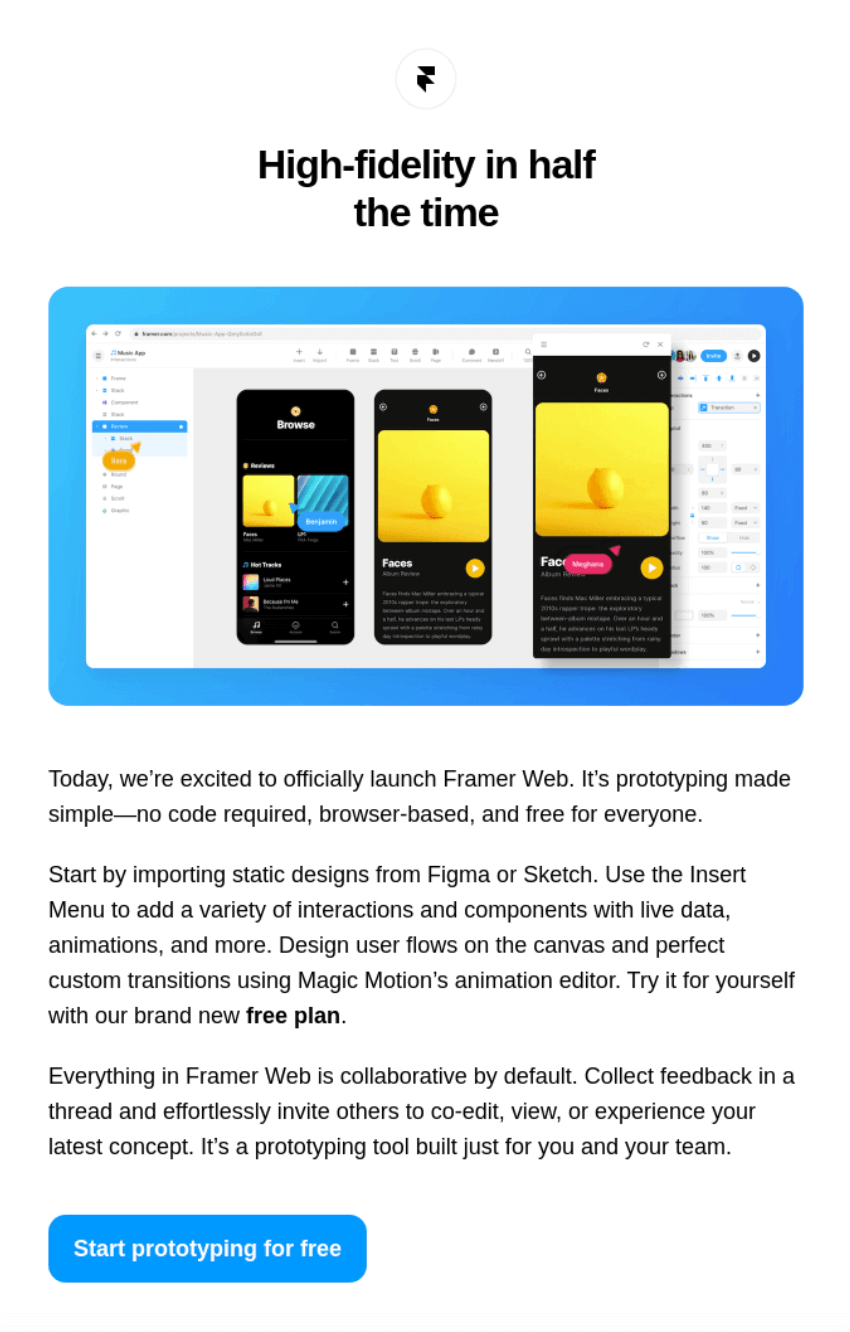
Above, you can see a re-engagement email drip campaign example from Framer. They took a product/feature update route with a minimalistic approach. You won’t see flashy designs or unique interactive elements here.
The copy isn’t promotional either – it simply describes the new feature. Yet it still offers a glimpse into the feature and attracts conversions with a free plan offer.
The choice of minimalistic approach isn’t accidental – Framer went with it considering the peculiarities of their target audience and buyer personas.
Key Takeaways:
- Base your reactivation drip campaign on research and tailor it to the needs of your target audience;
- Highlight the key features of the new product in a concise manner;
- Don’t forget to include a clear CTA button.
Customer Retention Drips
A customer retention drip campaign aims to keep the users coming back to your product. It could be an informational sequence offering tips or a series of promotional emails and recommendations. You could design a weekly newsletter or a quick challenge to maintain a constant connection with your audience.
Subject line: Don’t forget to finish Selling Sunset
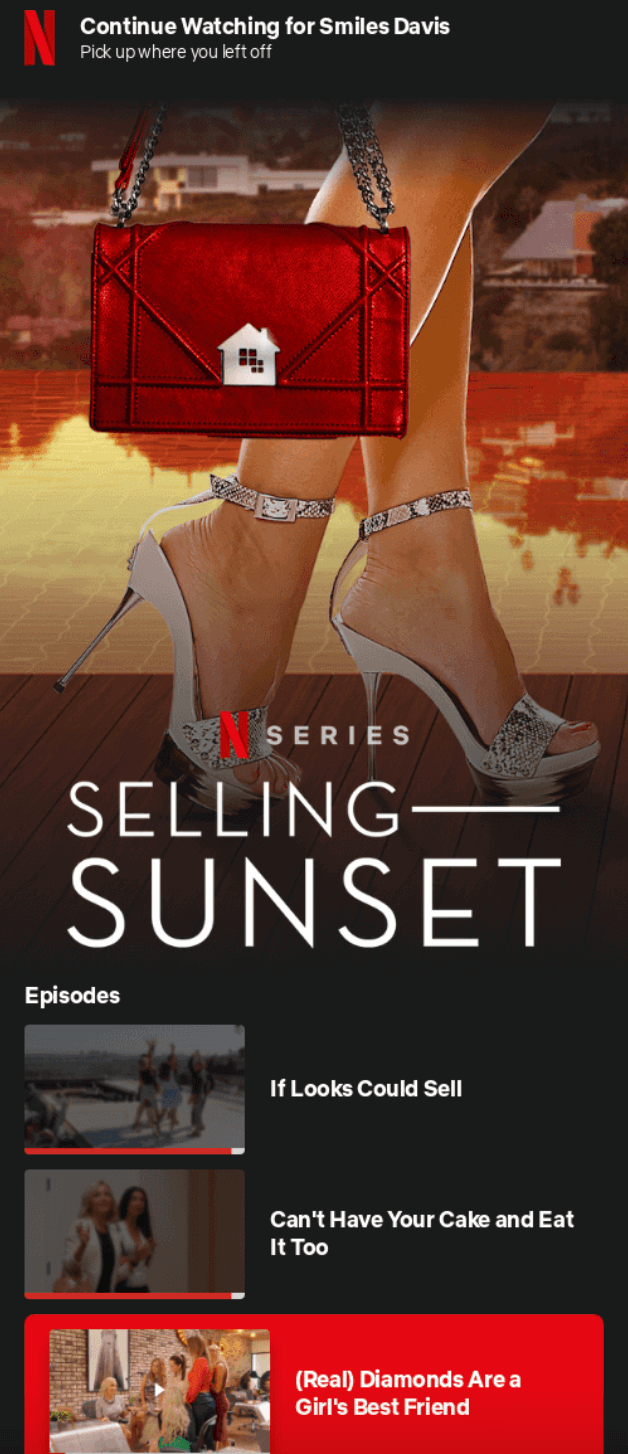
We don’t want to seem like avid Netflix fans, but they do have one of the most well-planned and executed email marketing strategies. Their customer retention drip campaigns heavily rely on data-driven personalization.
In this example, Netflix leverages the user’s watching history and motivates them to come back by showing the episode they paused. The email also includes additional recommendations that improve the user experience and keep them engaged.
Key Takeaways:
- Use data to optimize and personalize your customer retention drip marketing strategy;
- Use brand colors in drip email campaigns to make them memorable and recognizable;
- Strike a balance between customer retention and overcrowding the inbox.
Win-Back Campaigns
Win-back campaigns are sent to inactive subscribers who used to engage with or buy from you previously but have stopped for some time. The intention here is to re-engage them again with some interesting or a no-brainer offer. Here’s an example from a win-back drip sequence by Sourse.
Subject line: We’ll give you 25% off to open this email 🤑
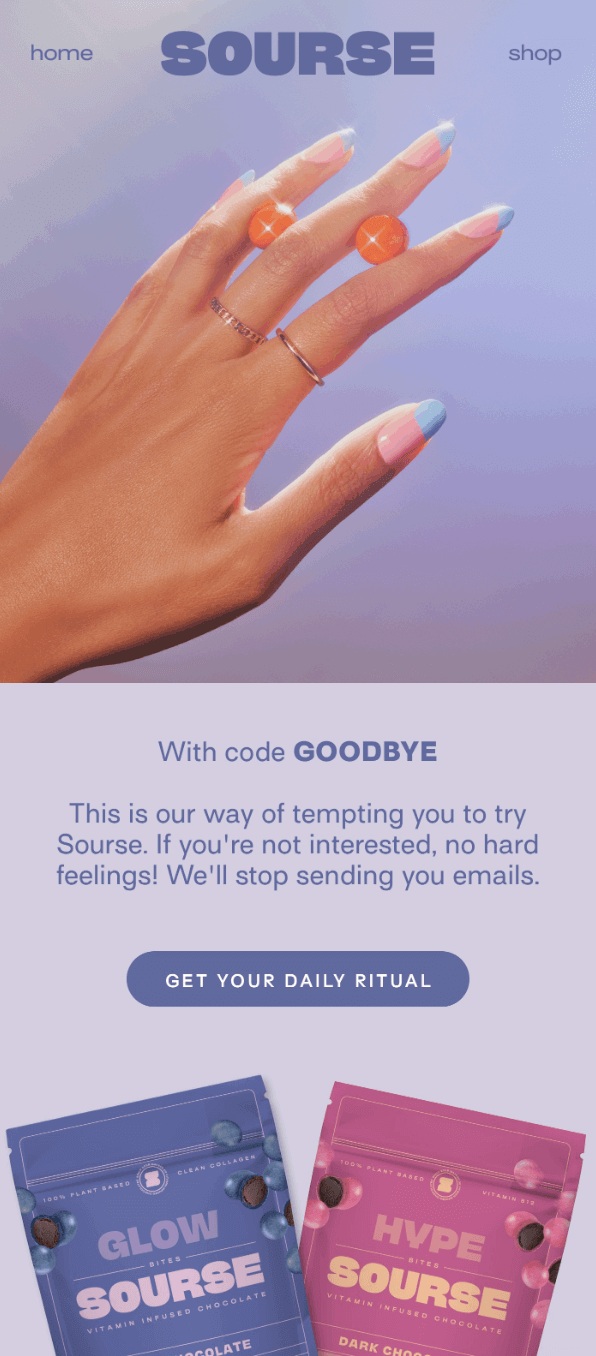
The subject line is quite compelling and would make many subscribers click instantly. The theme is simple, and the copy is direct.
The image highlights the product pretty well, and the coupon code makes the user wonder if they will try the product again. The CTA button is prominent too, which would’ve attracted clicks.
Why do we love it?
- Simple and direct copywriting;
- Offer in the subject line;
- Beautiful product placement image in the header.
Action Completion Drips
Action completion drip marketing campaigns are automated email campaigns triggered after the user completes a specific action or a specific event occurs. These can be membership renewal, content download, event registration, etc.
Subject line: Your agenda for Thursday, 10th October
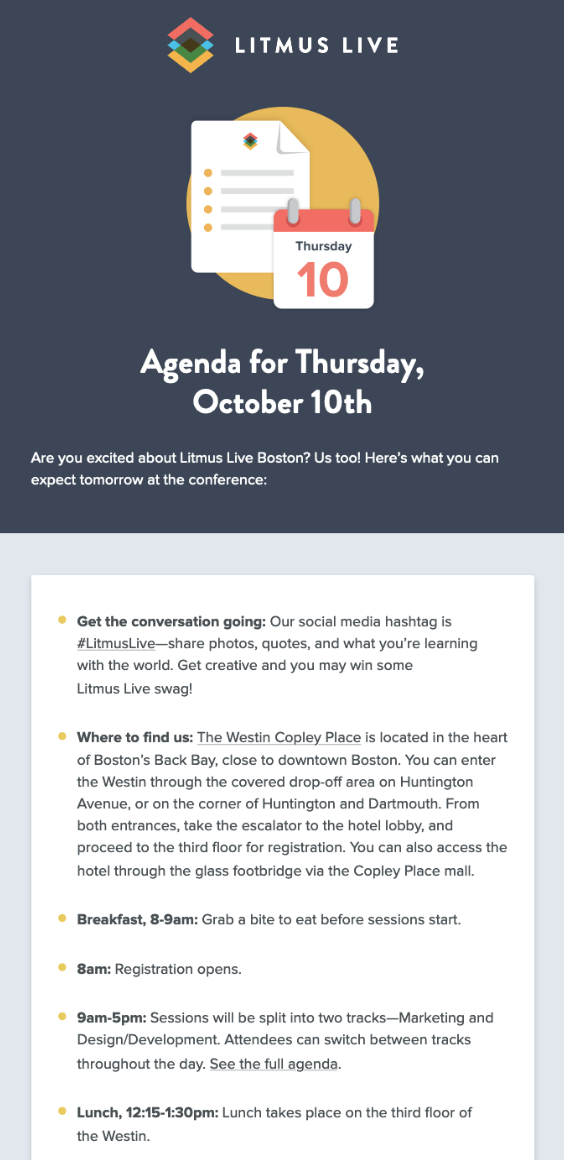
This action completion drip campaign from Litmus was triggered after the user registered for the Litmus Live event. It introduces the agenda of the meet-up and provides necessary instructions. The CTAs are quite subtle here as the email only intends to inform the user, not to promote any services or products.
The subsequent email may be a reminder on the day of the conference, or a thank you note after the event.
Key Takeaways:
- Try to build relationships when you leverage drip campaigns based on an action;
- Include all the necessary information in your emails or guide the users to it with clear CTAs;
- Keep the subject line simple and state directly which completed action it relates to.
Lead Nurturing Campaigns
A lead nurturing campaign is one of the most important sales drip campaign examples from which you should get inspiration. It helps build good customer relationships and move them to the different stages of the conversion funnel.
Such triggered emails are sent after the user abandons the cart, searches for a specific product, or the moment they sign up. The main idea is to automate emotion-based email sequences based on users’ action.
Subject line: Shop and save 30%. It’s on us.
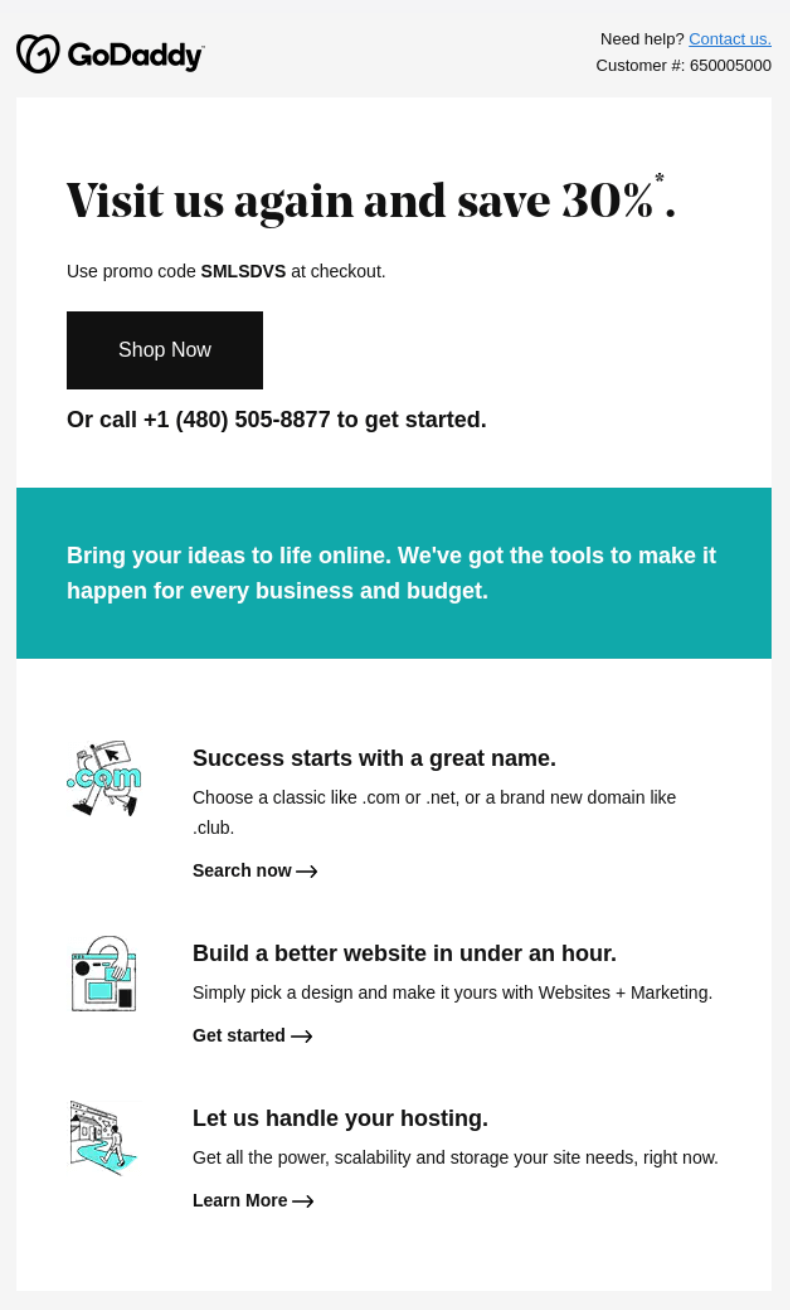
In the email drip campaign above, GoDaddy uses a 30% promotion to entice a second purchase. It highlights the value of the product and tops it off with straightforward CTA buttons.
Such an approach grabs the customer’s attention and encourages them to stay loyal to the brand.
Key Takeaways:
- Nurture the leads by offering a discount, exclusive deal, or VIP membership for their future purchases to make them feel special;
- Address the user’s pain points and underline the value of your product;
- Personalize your email with a unique promo code or helpful insights specific to that particular subscriber.
Also read: Getting Email Nurturing Right: Campaign Success Tips
Post-Purchase Email Drip Campaign
Post-purchase drip campaigns can supplement your marketing efforts significantly, especially if you want to increase customer lifetime value. These are automated email sequences triggered after the user purchases your product or service.
While the first email will mostly confirm the transaction, the follow-up emails will be a blend of delivery notifications and informative sequences.
Subject line: Your BNA > TXL Trip Details
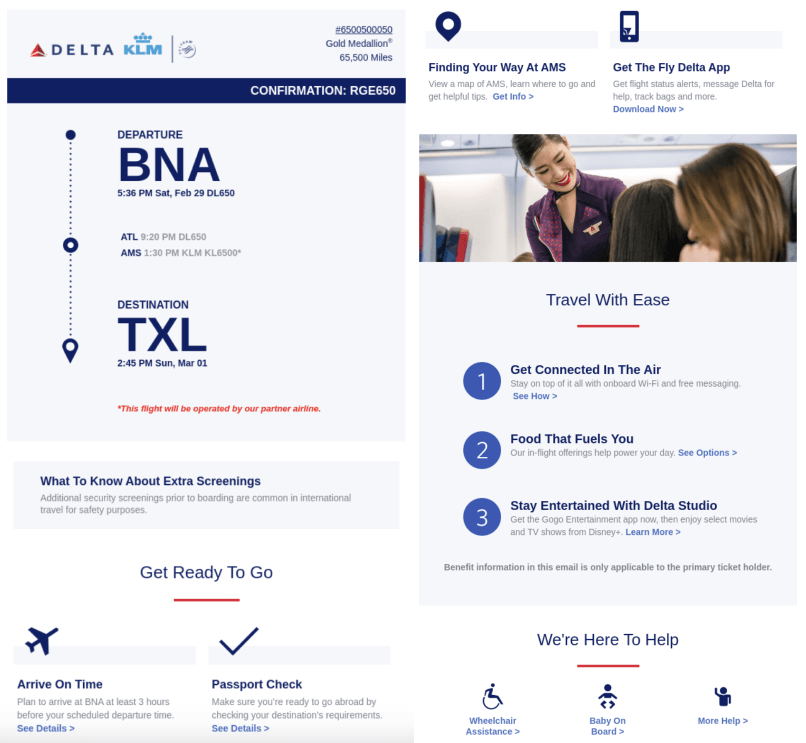
Here, you can see a post-purchase campaign from Delta Air Lines. Apart from confirming the flight, the email includes additional information with links to useful resources. Then the email highlights the services the passenger will benefit from on-board.
Finally, Delta Air Lines showcases its inclusivity with accessibility features.
Notice that the email doesn’t include any aggressive CTAs. The purchase is already made, so the focus has shifted from selling specific services to showing superior customer care. So, instead of ‘Get this deal now’, Delta Air Lines uses CTAs such as ‘See Details’, ‘Get Info’, and ‘Download Now’.
Key Takeaways:
- Design post-purchase drip campaigns with the goal of turning first-time buyers into loyal customers;
- Diversify your sequences by topping off confirmations or reminders with guides, additional information, or links to useful resources;
- Highlight attractive features and services to set the mood for future purchases.
Also read: 13 Post-Purchase Email Ideas that Boost Customer Experience
Cart Abandonment Campaign
Cart abandonment is when users add items to their cart but don’t actually place an order. It could be because they changed their mind, had trouble completing orders, or simply forgot to finish the purchase.
Either way, a simple card abandonment drip campaign can act as a reminder that results in completed orders. It’s a great way to retain customers for ecommerce stores and other businesses.
Subject line: Where’d you go?
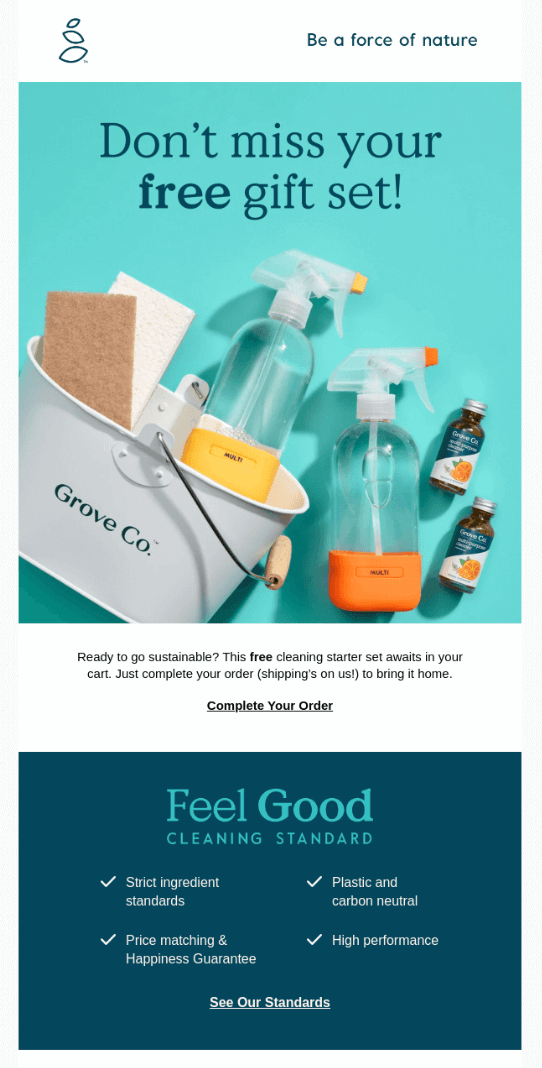
In this example of a cart abandonment drip campaign, Grove Collaborative motivates the user to complete the purchase by offering a free gift with their order.
Such an approach makes it possible to avoid being too pushy while still achieving the goal. To seal the deal, Grove Collaborative throws in free shipping and highlights the brand’s values.
Key Takeaways:
- Don’t try to push sales in the first email. Instead, analyze the reason behind cart abandonment and address the issue;
- If possible, throw in some freebies;
- Highlight the distinguishing characteristics of your product, brand, or business.
If you can’t suggest free gift sets like Grove Collaborative, check out these abandoned cart email templates for more inspiration on how to make your abandoned cart campaigns engaging.
Upselling Drips
Upselling drip campaigns allow marketers to promote a more expensive version of the product, subscription, or service the customer is already using. For example, if you’re using a free trial of a photo editor app, you’ll receive an upselling email sequence.
It will highlight the benefits of the paid version to tempt you to make the purchase. The trigger could be a trial expiration or an attempt to use a pro feature.
Subject line: Get to the trails quicker with this AllTrails+ feature
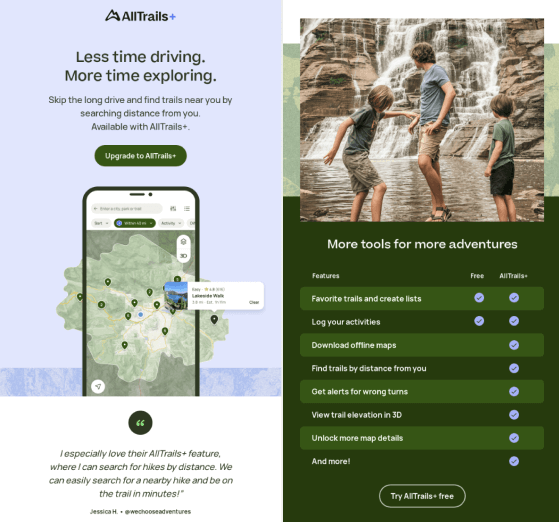
Let’s take a look at the upselling drip from AllTrails. The email starts with a simple, straight-to-the-point copy. It’s topped with a value proposition and a clear CTA button.
A strong addition to the email is the testimonial. Not only does it upsell the AllTrails+, but it also reinforces the benefits with a customer review.
At the bottom of the email, we see the comparison between the free and the paid version. The second CTA button invites the users to try the AllTrails+ for free to seal the deal.
Key Takeaways:
- Highlight the value of the product you’re upselling by including testimonials such as reviews and success stories;
- Offer additional benefits (exclusive membership, free trial, early access, etc.);
- Build up the trust and warm up the audience before sending the upselling drip campaign.
Engagement Drip
As the name suggests, engagement email drip campaigns are sent with the only purpose of raising specific actions from the users. Although these aren’t direct sale emails, the micro-commitment shown by loyal subscribers is very important in the long run.
Engagement emails help improve deliverability as user interaction is one of the key elements of making it to the inbox. They also increase brand loyalty and invoke actions that bring customers closer to checkout.
Subject line: How do you run?
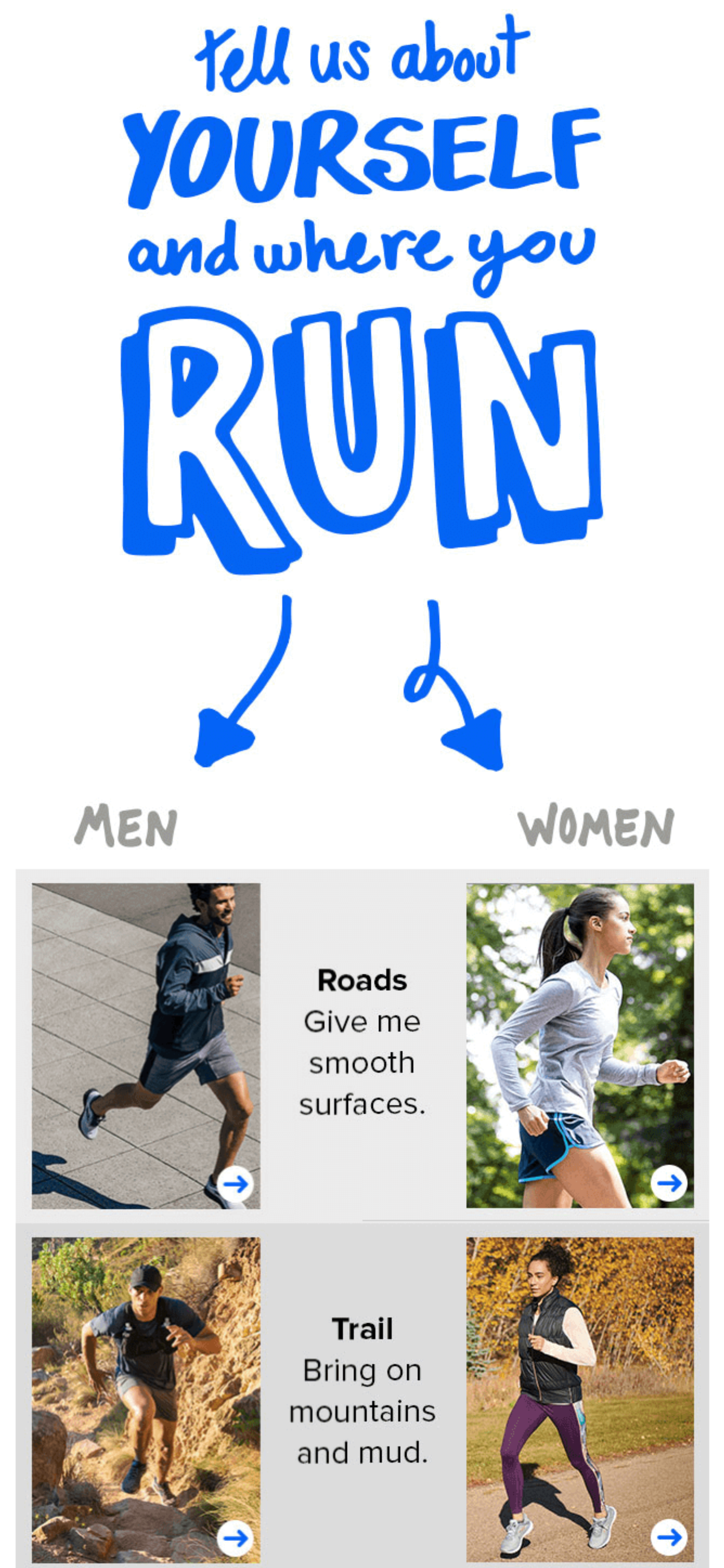
In the example above, Brooks Running, a US-based athletic shoes and apparel company, tried to amp up engagement with an exciting twist. They started the email by painting a picture of an enjoyable run to set the mood for the rest of the email. The copy places subscribers in the center of attention as it asks them to share information about their preferences.
With such an approach, Brooks Running collects more clicks and directs users right to their online store.
Key Takeaways:
- When creating an engagement drip campaign, include elements that interact with the reader directly. This could be a question, quiz, creative video, or animation.
- Steer away from ‘salesy’ CTAs – theme-matching CTA buttons will work better;
- Use moderate humor or creative touches to grab the reader’s attention from the beginning of the email.
Deepen your knowledge on what is customer engagement, its definition, and importance.
Recommendations Drip
Recommendation drip sequences provide relevant and timely “next steps” to your users and extend the customer life cycle. By following the recommendations, they can continue using your product or service in a way that adds value to both of your lives.
Subject line: Top 3 Blinkist titles that everyone’s loving
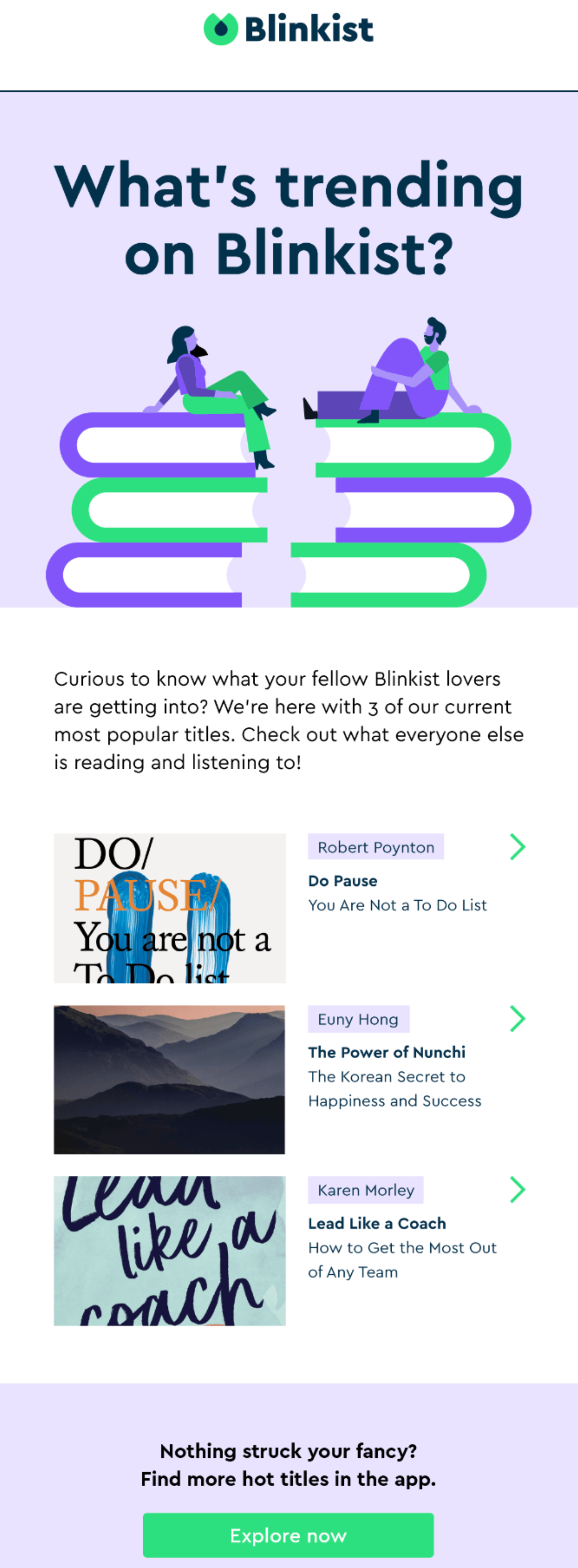
Blinkist uses recommendation drip campaigns actively to bring existing customers toward their subsequent reads. They employ simple messaging and relevant recommendations to ensure the user is hooked to the app. This results in lasting relationships and continual membership renewals.
Blinkist also creates a sense of community by picking out the most popular books among other readers.
Key Takeaways:
- Analyze the past purchasing habits of your subscribers to provide recommendations they will actually like;
- Include links to the recommended products or services to make it easier for subscribers to take action;
- Create a sense of community and belonging to build loyalty.
Renewals Drip
Customer acquisition is one thing, but many businesses depend upon monthly subscriptions from existing customers. A renewal email drip campaign can be a great way to wake your customers up and remind them of their monthly dues.
Subject line: Friendly Reminder: Your Subscription Will Renew in 60 Days
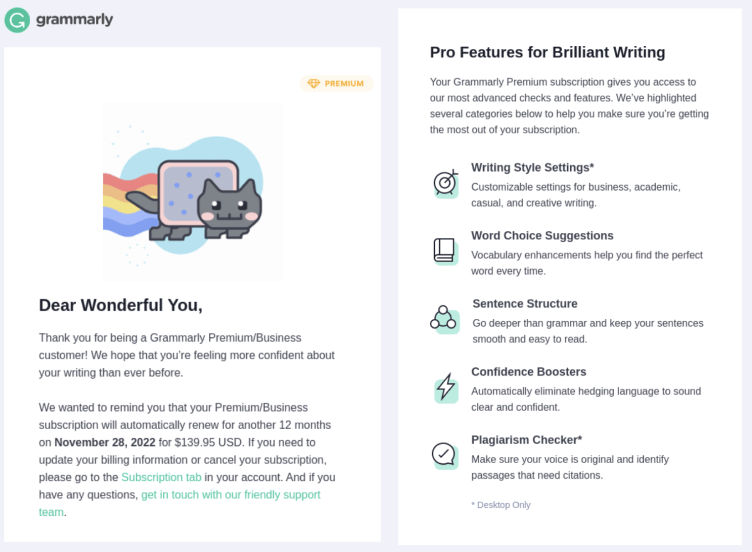
Grammarly is another company that always delivers well-crafted, on-point email campaigns. This time, they created a renewal drip sequence that checks all the boxes. From the very first sentences, the email sets a welcoming mood by thanking the subscriber for using their product.
They follow it with a renewal reminder and provide options for updating billing information or canceling the membership. Showing off their top-notch customer care, Grammarly also included a prompt to contact support in case of questions.
Finally, the email highlights the features worth paying for to convince the subscriber to keep the membership.
Key Takeaways:
- Craft a renewal drip sequence that is benefit-oriented and educating;
- Remind the user what they stand to lose if they lose their membership;
- Show gratitude and appreciation for past commitment.
Informational/Educational Drip
Information drip marketing aims to educate and entertain prospects. Such campaigns improve the understanding of the user’s problems and provide possible solutions. They highlight why your product or service is the one that can help them out.
As a bonus, information drip campaigns keep the readers engaged and longing for the upcoming dose of helpful content.
Subject line: 5 habits you need for better hydration
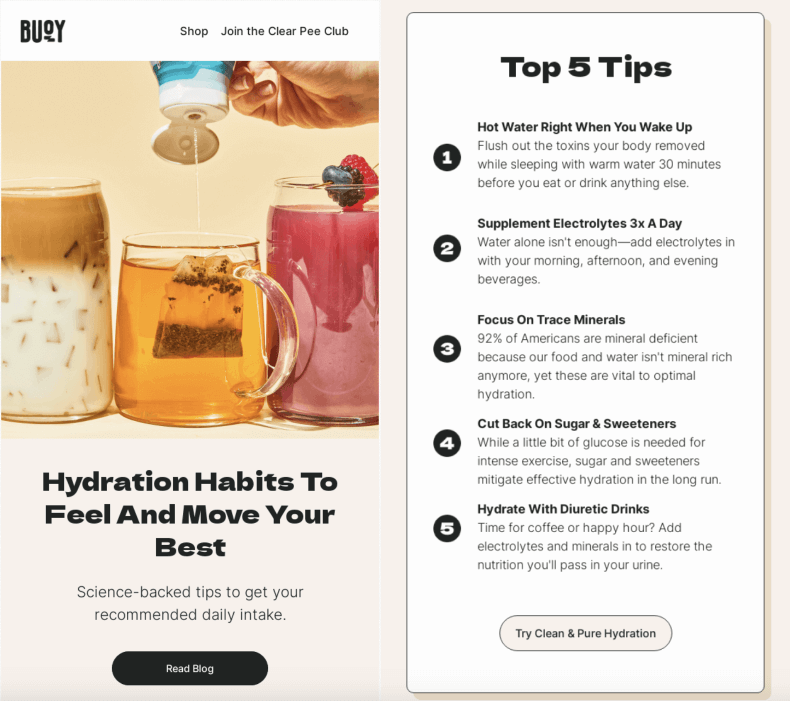
Hydration and wellness brand Buoy serves as a perfect drip example for an informational campaign.
First up, if the offer to “Join the Clear Pee Club” doesn’t get you, their aesthetically designed email containing their eye-catching product visual most definitely will. In addition, the infographic-like layout is easy to digest both for the eyes and for the brain.
This is a great way of combining an educational drip campaign with content marketing efforts.
Key Takeaways:
- Use formatting to separate chunks of text for better readability;
- Include only the most vital information – subscribers can read the rest in your blog or on your website;
- Design visually appealing and illustrative graphics that become part of the content themselves;
- Craft content about common pitfalls and show users how your product can become a simple solution.
Personalized Drip Campaign
A personalized drip campaign can serve any purpose, be it re-engagement, cart abandonment, or retention. Such sequences leverage customer data to create content that makes the subscribers feel special. This could be a mail merge about monthly/yearly recap, achievement notification, personalized recommendation, promotion on items the user purchased previously, etc.
Subject line: Really Good Emails, see your January updates: new ways to earn on YouTube and more
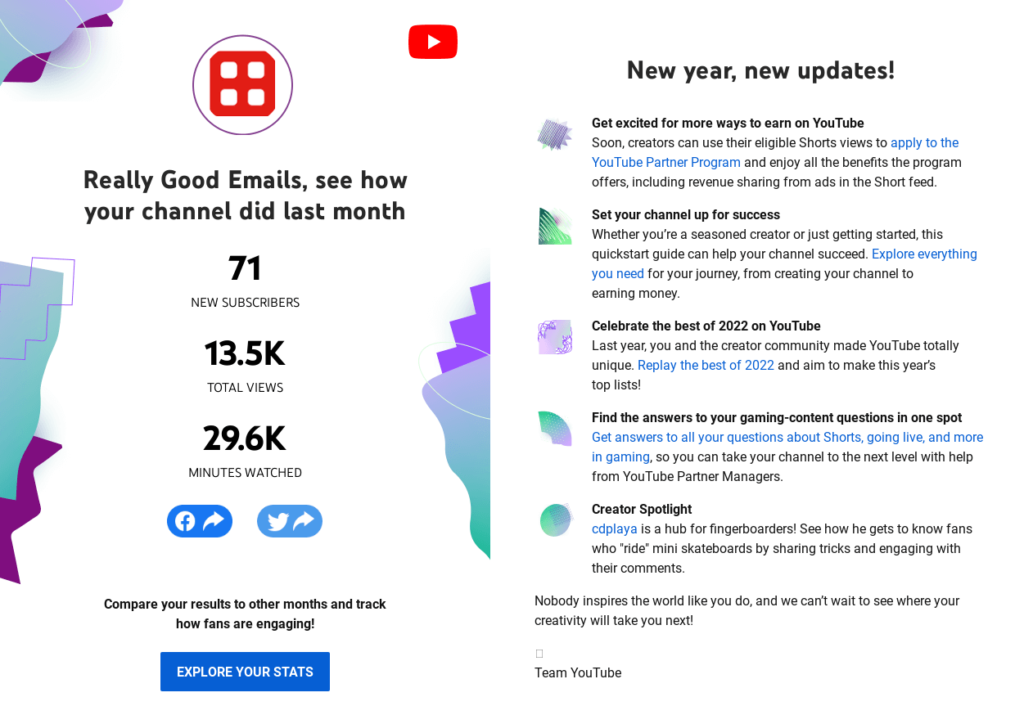
YouTube uses recaps to deliver personalized emails that highlight users’ achievements. In this example, they provide stats for the previous month right in the email and include a link, making the analytics more accessible. These numbers aren’t only entertaining, but they are also vital, particularly for content creators.
But YouTube didn’t stop there. They also recapped their updates to deliver more value.
Key Takeaways:
- Create detailed recaps that summarize the achievements of each subscriber and include the numbers that are actually important;
- Combine personal recaps with brand recaps for added value;
- Make sure you use customer data following privacy and security laws.
Feedback and Survey Emails
Feedback and survey emails are crucial parts of any drip marketing funnel for ecommerce brands. You’ve got an opportunity to understand if your customers love your products and services. Then use the insights to improve your proposition.
Here’s how Car Max sends a feedback email after someone finishes buying/interacting with the brand.
Subject line: Your opinion matters, Smiles Davis

The email is personalized, with the customer’s name in the subject line. They’re not beating around the bush in their email copy and have directly asked in the headline. The yellow-colored CTA button is attractive and unmissable.
There’s also an option to change language in the email, showing that they know their audience pretty well and haven’t ignored any segment.
Why do we love it?
- Simple and straightforward email layout;
- Prominent and bright CTA button;
- Multi-lingual email for non-English speakers.
What Makes a Good Drip Campaign?
For an email drip campaign to be successful, it should have the following characteristics and components:
- Carefully planned, moderate schedule. Sending dozens of emails the second a person signs up will tempt them to unsubscribe from your marketing communications. So, it’s necessary to devise a moderate schedule and set reasonable intervals between each sequence.
- Email sequences tailored to the customer journey stages. The customer journey is your audience’s standard flow while interacting with your brand. Consequently, every campaign, including your drip marketing ideas, should correspond with different stages of the customer journey;
- Templates for all possible triggers. Since drip campaigns are automated messages, it’s necessary to set possible triggers (sign-up, purchase, abandoned cart, etc.) depending on the peculiarities of your product or service. To speed up the processes, you should have prepared templates for each trigger;
- Clear subject lines. While subject lines should be catchy to attract the reader’s attention, they should also be self-explanatory. So, you should try to come up with simple subject lines that inform the users about the content of the email;
- Segmented audiences. Typically, audiences consist of various segments with different interests, goals, demographics, and backgrounds. You’ll get more engagement and conversions by personalizing drip campaigns based on audience interests and needs;
- Data-driven character. Modern marketing heavily relies on data. You’ll be able to improve customer retention, increase ROI, come up with viable predictions, and boost engagement by analyzing key performance metrics and users’ past behaviors.
Key Takeaways
Whew! We made it to the end. We hope you learned and took notes from the email drip marketing campaign examples above. These should be enough to convince you to try email marketing automation. Remember to:
- Run experiments and A/B test your drip campaign email to find winning subject lines, structures, tone of voice, CTA buttons, etc;
- Schedule strategically timed emails in your drip sequences that balance targeting a warm lead without appearing desperate;
- Pay attention to welcome and onboarding drip campaigns, as they can impact the user’s further interaction with your platform.
Pro Tip: Make sure to use a professional-looking business email address for drip campaigns – yourname@yourbrand.com is the perfect example.
If you’re looking for more valuable content, you might find these articles helpful:
